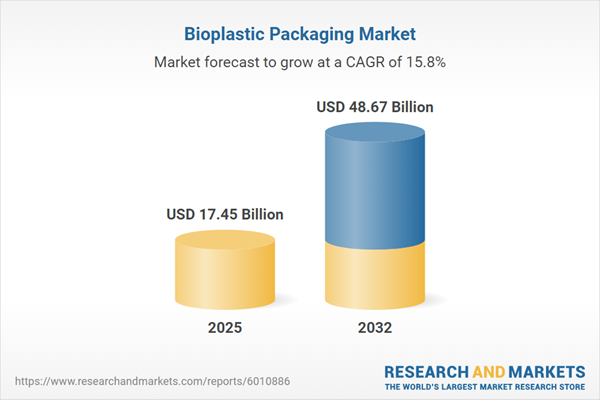Speak directly to the analyst to clarify any post sales queries you may have.
Bioplastic packaging solutions are gaining traction with senior leaders seeking procurement strategies that reinforce sustainability, streamline compliance, and build more resilient supply models. As market focus sharpens on responsible sourcing and measurable ESG outcomes, bioplastic packaging continues to influence enterprise supply chains worldwide.
Bioplastic Packaging Market Snapshot: Growth and Adoption
The global bioplastic packaging market is seeing robust growth, propelled by enterprise adoption and enhanced investment in sustainable packaging materials. In 2024, the market was valued at USD 15.02 billion; projections indicate an increase to USD 17.45 billion in 2025 and a jump to USD 48.67 billion by 2032, supported by a compound annual growth rate of 15.82%.
Major multinational organizations are leveraging bioplastic packaging to address evolving regulatory demands, implement renewable polymer innovations, and align with environmentally focused brand strategies. This trend highlights how rapid adoption and evolving supply chain expectations are redefining packaging standards, enabling enterprises to meet new sustainability benchmarks across global markets.Scope & Segmentation: Strategic Options for Enterprises
- Product Formats: Includes bags, pouches, bottles, containers, trays, films, and sheets, offering flexible and rigid solutions for various supply chain and logistics needs.
- Material Types: Options such as cellulose, polylactic acid (PLA), polyhydroxyalkanoates (PHA), and starch blends support circular business models, enhance durability, and facilitate sustainable end-of-life outcomes.
- Application Areas: Used in agriculture, food, consumer goods, healthcare, and pharmaceuticals, supporting requirements specific to product safety, integration, and compliance within regulated environments.
- Processing Technologies: Methods including blow molding, extrusion, injection molding, and thermoforming provide adaptable and scalable production to suit enterprise capacity and compliance targets.
- Geographic Coverage: Adoption is significant in the Americas, EMEA, and Asia-Pacific, with focal points in the United States, Canada, Brazil, Germany, France, China, India, Japan, and Australia—regions where supply chain hubs are strategically established for efficiency and regulatory alignment.
- Company Coverage: Leading suppliers—such as NatureWorks LLC, TotalEnergies Corbion B.V., BASF SE, Novamont S.p.A., Braskem S.A., Danimer Scientific, Mitsubishi Chemical Corporation, FKuR Kunststoff GmbH, Synbra Technology B.V., and Biome Bioplastics Limited—drive sector innovation via R&D initiatives and strategic partnerships that facilitate enterprise-scale integration of bioplastic solutions.
Key Takeaways for Senior Decision-Makers
- Structured and transparent sustainability reporting is achievable through bioplastic packaging, ensuring alignment with expanding regulatory frameworks and ESG priorities.
- Continuous research and development enable enterprises to build tailored packaging portfolios for sectors with complex requirements, such as healthcare and food services.
- Traceability in bioplastic packaging supply chains strengthens ESG performance and consolidates relationships with suppliers prioritizing quality and sustainability.
- Partnering with multiple suppliers, converters, and recyclers minimizes sourcing and compliance risk, supporting uninterrupted business operations during regulatory transitions.
- Advanced automation and processing capabilities help companies adapt swiftly to changing client expectations and new packaging standards, enhancing operational agility.
Tariff Impact: Navigating 2025 Tariffs on Bioplastic Packaging
With new tariffs anticipated for bioplastic raw materials and finished goods in 2025, organizations are adjusting procurement by prioritizing regional sourcing and strengthening biorefining operations. These approaches support emissions reduction, lower exposure to market fluctuations, and maintain effective alignment with evolving sustainability criteria. Enterprises that proactively implement these measures can reinforce operational frameworks, maintain compliance, and safeguard supply chains against potential disruptions.
Methodology & Data Sources
This analysis incorporates aggregated industry statistics, peer-reviewed publications, patent reviews, and regulatory data. Insights from polymer specialists, compliance advisors, and supplier organizations—supplemented by scenario-based enterprise surveys—ensure findings are actionable for senior decision-makers planning supply chain and procurement strategies.
Why This Report Matters: Bioplastic Packaging Market
- Empowers leadership teams to make informed procurement and risk management decisions under dynamic regulatory conditions in the bioplastic packaging market.
- Provides frameworks for efficient regulatory preparedness and certification efforts, supporting organizational responses to new sustainability requirements.
- Equips organizations to optimize ESG initiatives while navigating evolving global supply chain and compliance contexts.
Conclusion
Bioplastic packaging delivers a practical tool for enterprises to integrate sustainability goals, enhance supplier relationships, and build flexible, future-ready supply chains. These strategic insights guide leaders in aligning operations with ESG and regulatory priorities.
Additional Product Information:
- Purchase of this report includes 1 year online access with quarterly updates.
- This report can be updated on request. Please contact our Customer Experience team using the Ask a Question widget on our website.
Table of Contents
3. Executive Summary
4. Market Overview
7. Cumulative Impact of Artificial Intelligence 2025
Companies Mentioned
The companies profiled in this Bioplastic Packaging market report include:- NatureWorks LLC
- TotalEnergies Corbion B.V.
- BASF SE
- Novamont S.p.A.
- Braskem S.A.
- Danimer Scientific, Inc.
- Mitsubishi Chemical Corporation
- FKuR Kunststoff GmbH
- Synbra Technology B.V.
- Biome Bioplastics Limited
Table Information
| Report Attribute | Details |
|---|---|
| No. of Pages | 196 |
| Published | October 2025 |
| Forecast Period | 2025 - 2032 |
| Estimated Market Value ( USD | $ 17.45 Billion |
| Forecasted Market Value ( USD | $ 48.67 Billion |
| Compound Annual Growth Rate | 15.8% |
| Regions Covered | Global |
| No. of Companies Mentioned | 11 |









